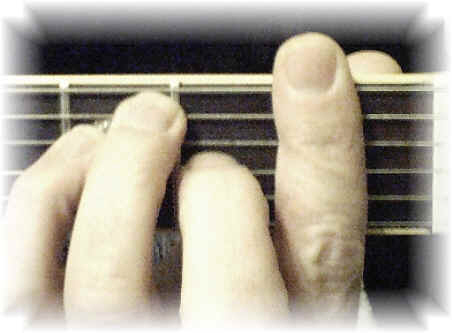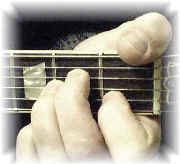|
 
           
Always remember when you play chords, have your fingers
fret the chords as close to the fret as possible. We will begin by explaining the E chord.
This guitar chord is very
important because it can easily be converted to many bar chords. When you
bar the E chord, it has now been converted to a movable major
chord. You can now play over 15 different chords by moving this root 6, E bar
chord to different positions of the guitar.
The E bar chord is a Root 6 bar chord, which means the chord is
determined by the note on the 6th string. Remember the 6th string is the
Low E string. Look at the illustration below.
|

The open E chord above.

|
 | The first image to the left is
the E major chord in the open position. You can use this chord to construct movable root 6 bar chords. Take a
look at the image below the E, notice the same fingering pattern is being played along with the
index finger. |
 | The second image is the F major chord. Notice the
index finger is behind the 1st fret and the other fingers have the same
fingering as the open E chord. The note on the first fret Low
E 6th string is
the F note. Also notice that the index finger is close to the
fret. |
 |
The chord is now the F major chord after being barred at the first
fret. The root 6 E type bar chord can be played all along the Low E string. The note of the
Low E string,
index finger determines the major chord being played. |
|

 |
 | Here is the root 6 type bar chord played using your thumb. The note on the
Low E string determines the chord. This chord is being played at the 5th fret and would now be the A major chord. Notice
the index finger playing the two notes on the B and high E string. |
|
 |
 | Here is the same A chord played at the 5th fret, but this time using the 1
finger in place of the thumb. Notice the other fingers have the same fingering as the open E chord. This is why it
is often referred to the E type bar chord. But, it is also called the root 6 bar chord. The chord is determined by
the note of Low E string or 6th string. |
 | Use this fingering pattern to play all the major chords up and down the fret board. This would be the A major
chord at the fifth fret, but with the same fingering moved to the 7th fret would be the B major chord. |
|

|

D minor chord above

A minor chord
|
 | Notice the chord being illustrated now. This is called a root 5 minor type
bar chord. This chord gets its name from the notes played along the A string. You can move this bar chord up and down
the fretboard to play all the minor chords. Notice that this bar chord uses the fingering pattern of the open
position A minor chord. The chord to the left has the index finger on the 5th fret. Look at the illustration above
and find the D note 5th fret on the A string. This type of minor bar chord uses the open Am chord, along with the
index finger. Since the index finger is at the D note, A string it would be the Dm chord. The notes of the Dm
chord are D F and A. This means since the A note is in the Dm chord, we can play that A note 5th fret low E
string. But, you must understand that the chord being played is the Dm chord and you should know that the chord is
determined by the note on the D string. This means, you don't have to play the note on the Low
E string. If we moved this fingering pattern to the 3rd fret, we would be playing the C minor chord. If we
played this fingering pattern at the 2nd fret, we would have the Bm chord and so on. |
 | The chord to the left is the Am chord in the open position. We can use this chord to play all the minor chords
up and down the fretboard, just like we used the E chord. This chord uses the A string to determine the chord
being played. |
|
|

G bar chord 3rd fret |
|
Now you have learned that you can easily convert the open
E chord to the movable bar chord and play over 15 different chords on
the guitar. The root 6 or E type bar chord is determined by the note on Low
E 6th string. Play this
chord on every fret possible along the Low E string and notice which chord it would be.
I have also illustrated the root 5 minor bar chord. You use the Am chord along with the index finger to play all the
chords that are determined by the note along the A string.
Good luck,
From The Jam Room
|






















